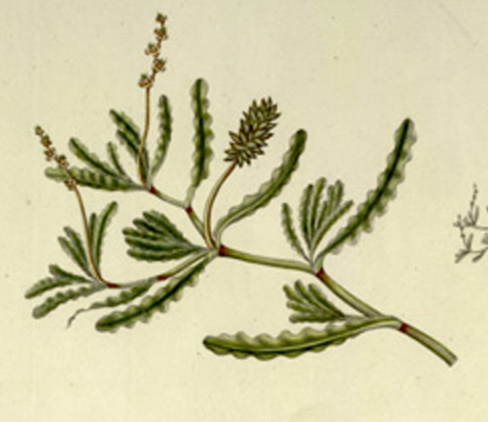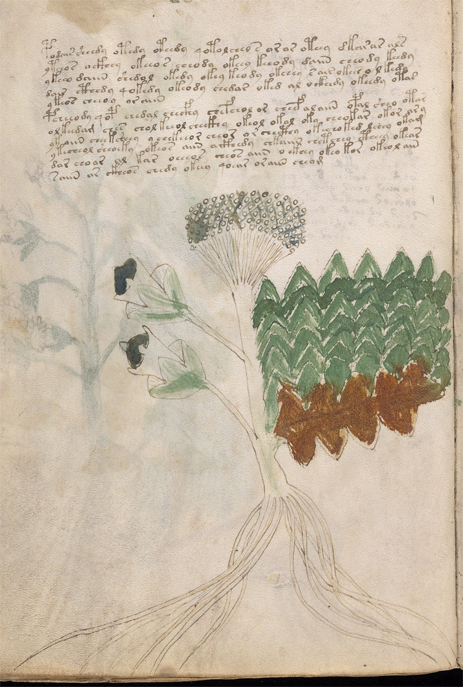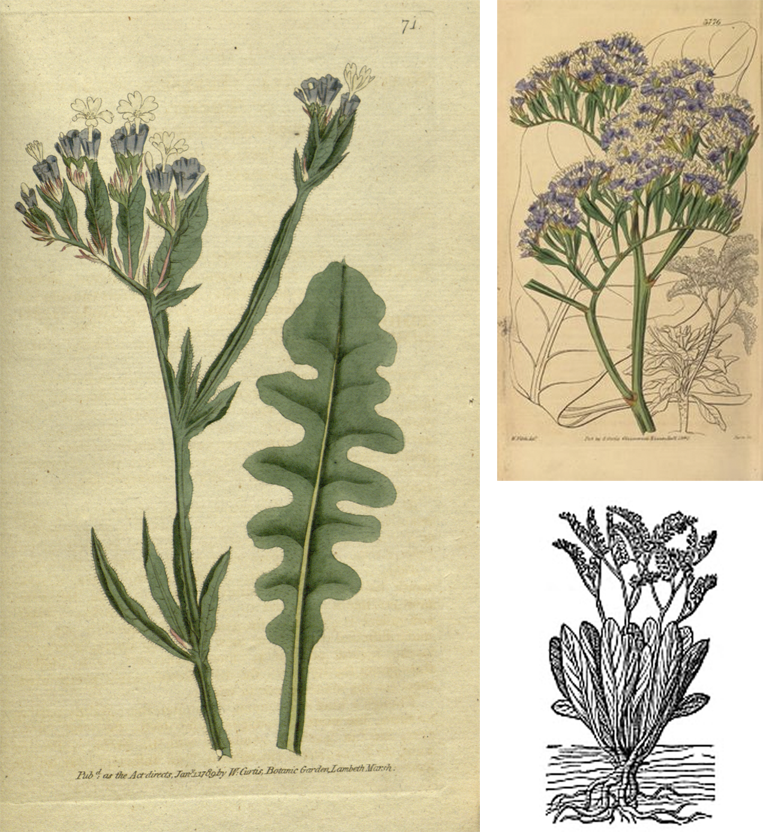This is not one of the plant IDs I uploaded in 2013. I couldn’t decide whether the pose of the plant was symbolic or naturalistic and was hesitant to post it. My original ID assumed a literal expression of certain characteristics of the plant which I see as pinnate leaves, asymmetric flowers, and possibly a clumpy seedhead.
Nine years have passed since my initial assessment of the plant and I still haven’t figured out whether this plant is naturalistic or symbolic. Is it a symmetrical plant that has been rearranged to look like an angel or other symbolic shape? Or is it an asymmetric plant? So much time has passed without an answer, I have decided to post my original (naturalistic) ID as I continue to search for symbolic interpretations.
Plant 31v is a markedly asymmetric drawing. It’s not unusual for plants to have asymmetric flowers, but asymmetric leaves are less common and those with asymmetric lobed leaves quite rare.
The two branches on the left might be closeups of the flowers or the seedheads. The clump at the top might indicate the growth habit of the flowers or seeds, which may appear as a tight clump.
The leaves are distinctive. Besides the jaggy lobes, the closest one is brown and the rest green. Plants with mostly green leaves sometimes have some that turn red or brown long before the others, so this can sometimes help identify a plant, but one has to look at all the plant’s attributes before deciding what the two tones might mean.
The roots are very long and slender and have been left unpainted, as has most of the stalk. The flowers or seeds are painted blue but the VMS palette is limited and blue has been chosen for many of the flowerheads, particularly those that look like they might be seeds, so it may not represent the color of the flowers.
Prior Identifications
 Edith Sherwood has identified 31v as Valerian. I’ll agree that the roots are a good match, but I don’t think it’s the most likely ID. The VMS leaves do not resemble Valerian, which is more feathery. As I posted in 2013, I think it’s more likely that Plant 90r is Valerian (Phu). Plant 31v is probably something else.
Edith Sherwood has identified 31v as Valerian. I’ll agree that the roots are a good match, but I don’t think it’s the most likely ID. The VMS leaves do not resemble Valerian, which is more feathery. As I posted in 2013, I think it’s more likely that Plant 90r is Valerian (Phu). Plant 31v is probably something else.
Other Possibilities
Based on the leaves, it occurred to me that this might be a thistle or Acanthus plant, or perhaps even one of the many dandelions or hawkweeds, but the VMS flowers or seedheads differ in some important ways from thistles and asters. The same is true of Pedicularis, Gerbera linnaei, Sonchus congestus, or Hyoseris—the leaves match moderately well, but the flowers don’t.
Narrowing it down to plants that fit as many features of the VMS drawing as possible, I ended up with two that stood out more than others—one is inherently asymmetric and the other matches the VMS plant fairly well while suggesting asymmetry in another way…
Limonium sinuatum (Statice sinuata)
Limonium sinuatum is a Mediterranean plant with lobed (pinnatifid) leaves that match fairly well to the VMS. They are similar in shape to dandelion leaves. The flowers are asymmetric but the florets sometimes clump into masses so thick they look almost like rounded puffs, which might explain the two kinds of “flowers” in the drawings. Like the VMS, the tendril-like roots are stringy:
Despite the similarities, I wasn’t completely satisfied with this ID… the leaves of Limonium sinuatum are symmetric and I couldn’t find any references to angels or other anthropomorphic symbols that might explain the asymmetry or human-like pose of the VMS drawing.
Was there a plant that matched the VMS plant more closely?
Potamogeton crispus
 There is a widespread Mediterranean/Eurasian pondweed that might explain the asymmetry of the VMS drawing. It’s called Potamogeton crispus, a plant with distinctively lobed and rippled leaves that are green or brown and sometimes both green and brown. In fact, the lobes and brownish color are distinguishing characteristics.
There is a widespread Mediterranean/Eurasian pondweed that might explain the asymmetry of the VMS drawing. It’s called Potamogeton crispus, a plant with distinctively lobed and rippled leaves that are green or brown and sometimes both green and brown. In fact, the lobes and brownish color are distinguishing characteristics.
Another interesting characteristic of this pond-weed is the two kinds of stalks, one with small individual knobs, the other with clumps (see below). The clumps are not as thick as those in the VMS drawing, but this duality might help explain the way the VMS plant is drawn. If it’s not intended to be Potamogeton, perhaps it’s a similar plant with dual stalks.
Like the VMS drawing, the stems of Potamogeton crispus are quite a bit lighter than the leaves, and the rhizomes long and slender.
But what about asymmetry? Potamogeton crispus is not an inherently asymmetrical plant but pond plants sway with the movement of the water and will often look asymmetric as parts of the plant are pushed farther from the others. A stronger current can cause leaves to orient in one direction, sometimes forming clumps. All these characteristics may be found in the 31v drawing.
Are you skeptical that an aquatic plant might be in the VMS?
Aquatic plants, and plants that stand in water for parts of the year, are very well represented in medieval herbals. Duckweed is often included, as are Nuphar and Nenuphar, Mentha Aquatica, Caltha palustris, Sagittaria, Acorus, Petasites, Bistorta, Alisma, Equisetum, buckbean, Polygonum, frogbit, water-cress, sedge, Cyperus, and Veronica. Sometimes one finds Villarsia. Even seaweed is sometimes represented.
Summary
I’m not as confident about these IDs as I am about some of the others, but I think they should be considered and I haven’t seen anyone else suggest Limonium sinuatum or Potamogeton crispus as possibiities for 31v, so regardless of whether they stand the test of time, I thought it was important to give them due consideration.
J.K. Petersen
Copyright © 2018 March 17, All Rights Reserved



